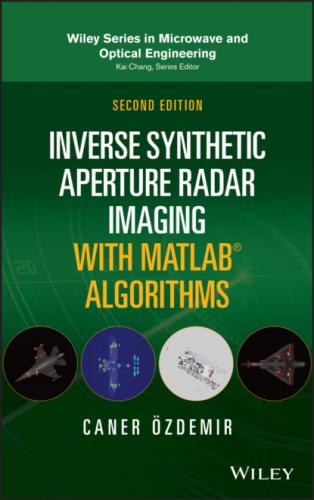Table of Contents
1 Cover
6 Preface to the Second Edition
8 Acronyms
9 1 Basics of Fourier Analysis 1.1 Forward and Inverse Fourier Transform 1.2 FT Rules and Pairs 1.3 Time‐Frequency Representation of a Signal 1.4 Convolution and Multiplication Using FT 1.5 Filtering/Windowing 1.6 Data Sampling 1.7 DFT and FFT 1.8 Aliasing 1.9 Importance of FT in Radar Imaging 1.10 Effect of Aliasing in Radar Imaging 1.11 Matlab Codes References
10 2 Radar Fundamentals 2.1 Electromagnetic Scattering 2.2 Scattering from PECs 2.3 Radar Cross Section 2.4 Radar Range Equation 2.5 Range of Radar Detection 2.6 Radar Waveforms 2.7 Pulsed Radar 2.8 Matlab Codes References
11 3 Synthetic Aperture Radar 3.1 SAR Modes 3.2 SAR System Design 3.3 Resolutions in SAR 3.4 SAR Image Formation 3.5 Range Compression 3.6 Azimuth Compression 3.7 SAR Imaging 3.8 SAR Focusing Algorithms 3.9 Example of a Real SAR Imagery 3.10 Problems in SAR Imaging 3.11 Advanced Topics in SAR 3.12 Matlab Codes References
12 4 Inverse Synthetic Aperture Radar Imaging and Its Basic Concepts 4.1 SAR versus ISAR 4.2 The Relation of Scattered Field to the Image Function in ISAR 4.3 One‐Dimensional (1D) Range Profile 4.4 1D Cross‐Range Profile 4.5 Two‐Dimensional (2D) ISAR Image Formation (Small Bandwidth, Small Angle) 4.6 2D ISAR Image Formation (Wide Bandwidth, Large Angles) 4.7 3D ISAR Image Formation 4.8 Matlab Codes References
13 5 Imaging Issues in Inverse Synthetic Aperture Radar 5.1 Fourier‐Related Issues 5.2 Image Aliasing 5.3 Polar Reformatting Revisited 5.4 Zero Padding 5.5 Point Spread Function 5.6 Windowing 5.7 Matlab Codes References
14
6 Range‐Doppler Inverse Synthetic Aperture Radar Processing
6.1 Scenarios for ISAR
6.2 ISAR Waveforms for Range‐Doppler Processing
6.3 Doppler Shift's Relation to Cross‐Range
6.4 Forming the Range‐Doppler Image
6.5 ISAR Receiver
6.6 Quadrature Detection
6.7 Range Alignment
6.8
